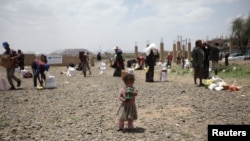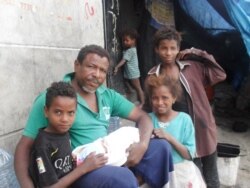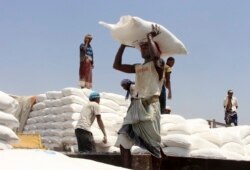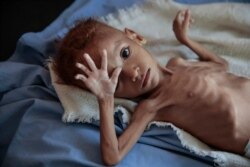The World Food Program’s partial aid suspension in Yemen has increased concerns for families.
Mohammed Qaid worries for his four-day-old boy Nazeh. Qaid has seven other children, and little hope that he can feed his family. But this family is not the only household feeling the pinch of the recent reduction in food aid delivered to Sana’a.
Qaid is among the thousands of residents in the Yemeni capital, Sana’a, a Houthi stronghold, who is dependent on international humanitarian aid in the midst of the conflict. The war has ravaged Qaid’s life, and his family now survives on scraps. "We're now sort of dependent on restaurants' leftover rice,” he told VOA. “We pay dishwashers $0.80 for collecting leftover rice."
Destitute and hungry, families have resorted to sending their children out to collect leftover rice granules. Qaid tells VOA his young sons were crying the morning of the interview because he could not afford to pay the cost of two eggs, opting instead for tea.
Normally, Qaid’s family would have received a monthly basket from the World Food Program consisting of 75 kilograms of wheat, two bottles of cooking oil, sugar, and lentils. That stopped when WFP shipments were held up due to a standoff between the agency and the Houthi authorities. Both sides had disagreed over who would be responsible for monitoring the food routing system. U.N. officials now say they have the Houthi's agreement to implement a biometric registration system to prevent diversion of food aid.
The WFP says partial food aid to 850,000 people in Sana'a will resume next week, but the relief is not coming soon enough for many struggling to survive as the war heads into its sixth year.
The conflict began in 2014 when the internationally-recognized government of President Abdrabbuh Mansur Hadi was run out of the capital, Sana’a, by Iranian-backed Houthi rebels. Prompted by rife political corruption and mounting civil unrest, the rebels took the capital and have been fighting against a coalition led by Saudi Arabia, which seeks to restore the previous government.
As the war rages, 13 million Yemeni civilians on the ground face starvation. U.N. officials say Yemen is suffering the world’s current largest humanitarian crisis and one of the largest man-induced famines in history.
Critics identify two main culprits. The first are the Houthi rebels, who have been accused of unlawfully confiscating food and reselling aid to fund the war. The second is Saudi Arabia, whose campaign of air strikes and bombings of civilians has been labelled by the international rights group Human Rights Watch as illegal. These attacks have not only made it difficult for Yemen to produce food, but also hampered efforts to get food aid to the people who need it most.
Aid workers say grain often rots as supply routes are regularly attacked. Saudi air strikes have not only targeted mosques, schools, stores and homes, but farms, grain storage units, seaports, and food factories.
The food shipments that do make it through are often not getting to where they are most needed. Speaking at the U.N. Security Council last year, WFP director David Beasley said there is “serious evidence that food was being diverted and going to the wrong people.” As many as 60% of residents of the capital, he said, were not receiving food.
WFP officials say using a biometric registration system that includes iris scanning, facial recognition, and fingerprints will help identify those who need aid the most and combat corruption in distribution.
Critics at the United Nations, WHO, and even within the United States, point to the U.S. role, which they say is propelling the conflict by selling billions of dollars’ worth of weapons to Saudi Arabia.
Last year, U.S. President Donald Trump said Saudi Arabia had agreed to spend $110 billion in “leading the fight against Radical Islamic Terrorism.” While the arms deal mostly consists of letters of intent and is a far smaller number than the detailed $110 billion, the kingdom’s anti-terrorism campaign, along with its efforts to contain Iranian influence, are in line with Washington’s wider strategic interests in the region. Houthis oppose this arms deal because they view Saudi Arabia as pandering to western influence and not supporting pan-Arab culture.
While some claim the U.S. bears indirect responsibility for Yemen’s food shortages, others point, paradoxically, to America’s role in saving millions of Yemenis from starvation. The United States donates approximately $2.5 billion annually--more than Britain, and Germany and other EU members combined.








